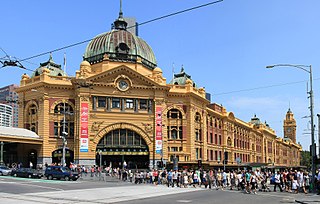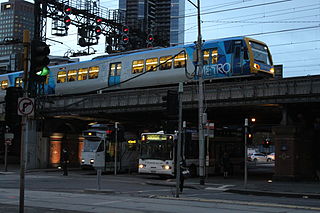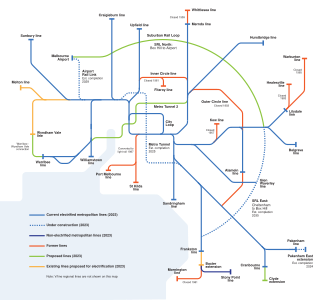
Proposals for expansion of the Melbourne rail network are commonly presented by political parties, government agencies, industry organisations and public transport advocacy groups. The extensions proposed take a variety of forms: electrification of existing routes to incorporate them into the suburban rail system; reconstruction of former passenger rail lines along pre-existing easements; entirely new routes intended to serve new areas with heavy rail or provide alternative routes in congested areas; or track amplification along existing routes to provide segregation of services. Other proposals are for the construction of new or relocated stations on existing lines, to provide improved access to public transport services.

The Melbourne rail network is a passenger and freight train system in the city of Melbourne, Victoria, Australia. The metropolitan passenger rail network is centred on the Melbourne CBD and consists of 222 stations across 16 lines, serving a yearly ridership of 243.2 million. It is the core of the larger Victorian railway network, with links to both intrastate and interstate systems.

Transport in Melbourne, the state capital of Victoria, Australia, consists of several interlinking modes. Melbourne is a hub for intercity, intracity and regional travel. Road-based transport accounts for most trips across many parts of the city, facilitated by Australia's largest freeway network. Public transport, including the world's largest tram network, trains and buses, also forms a key part of the transport system. Other dominant modes include walking, cycling and commercial-passenger vehicle services such as taxis.
VicRoads, or the Roads Corporation of Victoria, is a statutory corporation in the state of Victoria, Australia. In the state, it is responsible for driver licensing and vehicle registration, and regulating the accident towing industry in Victoria. It is part of the Department of Transport.
Transport law is the area of law dealing with transport. The laws can apply very broadly at a transport system level or more narrowly to transport things or activities within that system such as vehicles, things and behaviours. Transport law is generally found in two main areas:

The Transport Integration Act 2010 is a law enacted by the Parliament of the State of Victoria, Australia. The Act is the prime transport statute in Victoria, having replaced major parts of the Transport Act 1983, which was renamed as the Transport Act 1983.

The Department of Transport (DOT) was the government agency responsible for the coordination, integration and regulation of the transport system in the State of Victoria, Australia. The department generated planning, policy, and legislation for transport in Victoria. As a result, the department drove the integration of Victoria's transport land and water transport systems and the delivery of public transport, road and port services and associated activities across the State. The department's stated mission was "Building a safer, fairer and greener transport system for all Victorians to create a more prosperous and connected community."

The Director of Public Transport was the head of the Public Transport Division (PTD) of the Victorian Department of Transport. PTD was the government agency responsible for promoting, providing, coordinating and regulating public transport in the State of Victoria, Australia between August 1999 and April 2012. The Director of Public Transport was created as a statutory office supported by staff of the Department of Transport.
The Chief Investigator, Transport Safety is the independent Government agency responsible for investigation of safety-related trends and incidents in the rail, bus and marine industries in the State of Victoria, Australia.

Public Transport Victoria is the brand name for public transport in the Australian state of Victoria. It was the trading name of the Go Public Transport Development Authority (PTDA), a now-defunct statutory authority in Victoria, responsible for providing, coordinating, and promoting public transport.

Transport for NSW, sometimes abbreviated to TfNSW, and pronounced as Transport for New South Wales, is an agency of the New South Wales Government established on 1 November 2011, and is the leading transport and roads agency in New South Wales, Australia. The agency is a different entity to the New South Wales Department of Transport, a department of the New South Wales Government and the ultimate parent entity of Transport for NSW.
Melbourne Airport Rail is a rail link under construction from the Melbourne CBD to Melbourne Airport at Tullamarine. Since October 2022 the project has also been branded as SRL Airport. The rail link is to run through the under-construction Metro Tunnel, running 27 km from the airport to Town Hall station in the city centre with 12 km of new track between the airport and Sunshine station. The link will be a new branch of the Melbourne Metro rail network and run High-Capacity Metro Trains at a 10-minute frequency. The project is being delivered by the Victorian state government agency Rail Projects Victoria.

The Level Crossing Removal Project (LXRP) is a program of the Government of Victoria, Australia, to remove 110 level crossings and rebuild 51 railway stations in Melbourne.
Transport for Victoria is a statutory office of the Department of Transport that is responsible for the planning and coordination of all transport systems in Victoria, Australia.
The Department of Economic Development, Jobs, Transport and Resources (DEDJTR) is a former department of the Government of Victoria. It was created on 1 January 2015 by the government of Premier Daniel Andrews when the number of government departments was reduced from 9 to 7, and assumed responsibility for ministerial portfolios previously spread across 5 departments. It was abolished at the end of 2018 and divided into two new departments.

Rail Projects Victoria (RPV) is an agency of the Government of Victoria, Australia, responsible for the management of certain major infrastructure projects on the Victorian rail network. Originally established as the Melbourne Metro Rail Authority (MMRA), to deliver the Melbourne Metro Rail Project, the office was later expanded in its responsibilities to include the management and planning of a number of major infrastructure programs on V/Line's regional rail services. It was renamed RPV in 2018 to reflect its expanded scope, and later became one of several project teams comprising the Department of Transport's Major Transport Infrastructure Authority.

Melbourne Metro 2 (MM2) is a proposed extension to the Melbourne rail network, consisting of a tunnel from Newport to Clifton Hill via the city centre. Conceived as a follow-up project to the under-construction Metro Tunnel, MM2 would link the Werribee and Mernda suburban rail lines and include stations in the Fishermans Bend development precinct, at Southern Cross and at Parkville, allowing passengers to connect with Metro Tunnel and City Loop lines. Although MM2 has been proposed and refined by a number of government-led and independent reports and proposals, no funding or policy commitment to its planning or construction is in place as of 2022.

The Suburban Rail Loop (SRL) is a fully automated rapid transit system under construction in Melbourne, Victoria, Australia. The project would connect suburbs 15–25 kilometres (9.3–15.5 mi) from the Central Business District (CBD) along an approximately 90 km (56 mi) corridor. The two main stages, SRL East and SRL North, would together form a single 60 km (37 mi) orbital line with 13 stations between Cheltenham and Melbourne Airport, connecting eight existing Melbourne rail lines. The SRL Airport component, in the city's west, would be formed by the separate Melbourne Airport rail link project, which began construction in 2022.
The Department of Infrastructure (DOI) was a department of the Government of Victoria, Australia. Created in significant changes to the public service enacted by Jeff Kennett after he was returned as Premier of Victoria at the 1996 state election, the DOI oversaw a variety of functions until its abolition in 2008. It was responsible for transport policy during its entire existence, and consequently played a major role in the related reforms and projects initiated by Kennett and his successors. At different times, it also had responsibility for planning, major projects, local government, energy, communications, and mining.












